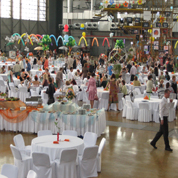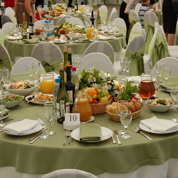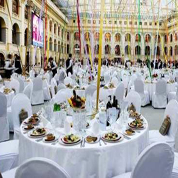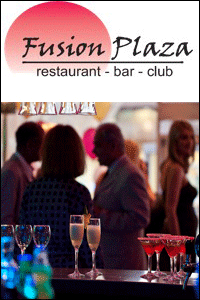The Russian catering services market

Major highlights, key players, trends, potential and growth forecasts
The beginning of the modern catering services market in post-Communist Russia is generally believed to be in the early 1990s, when a huge number of new local companies was founded and equally large number of foreign companies fluxed into the country as the previously centralized communist economy finally gave way to the birth of what would later go down in the contemporary history as the “era of jungle capitalism” and its equally negative twin sister, “the beginning of the accumulation of the initial capital.” As we all know, these two interrelated major socio-politico-economic phenomena later shaped the further development of modern Russia into its present state today, along with all its attendant “bad” and “good” consequences for the people and the economy.
However, the aim of this report is not the analysis of these phenomena, much less the negative impacts of the 1990s events, but the totally new spheres of entrepreneurial activities opened up by these radical changes of the early 1990s. One of these new positive trends was the need in then-mostly private-owned companies, especially those founded with foreign capital and/or managed by Western and foreign-trained Russian CEOs, to provide meals for staffs during working hours in an atmosphere and facilities that were far better than those offered in the traditional Soviet-era stolovayas or canteens.
The sought solutions to this problem evolved along two parallel paths. One envisaged “outsourcing” these feeding services to independent catering companies, which make the food and ship them to companies’ staffs, while the second path envisaged bringing the ‘meals-providing’ companies into the business premises — mainly major business centers or multiuse office properties — to offer these services “in-situ.” However, irrespective of the adopted methods, the whole process, fueled by the demand-supply law on one side as more companies came onboard, and the social aspect of such companies’ corporate welfare package policies for employees on the other hand, has gradually evolved over the years into a separate entrepreneurial venture, the catering services business, as we now know it today.
The catering services industry today
Broadly put, today’s caterers can be divided into two main groups — those offering “on-premise services” such organizing banquettes, picnics, etc., and those offering services on constant basis to companies such as daily feeding of staffs. Over the years, the Russian catering services industry has grown by leaps and bounds, especially in large cities such as Moscow, St. Petersburg and other towns with over a million residents, into a separate multibillion business segment in the  traditional restaurant industry.
traditional restaurant industry.
Thus, characterizing today’s Russian market, Victoria Polovnikova — the director of Catering Services at MegaFoods, one of the key leaders in this industry — noted that catering has now become a major component of all services offered in the country. “Market turnover has been growing robustly for the past three years. Today, catering companies are sprouting up at a very high frequency across the country, particularly in Moscow, where all the leading restaurants, which have a stable and solid clientele, are offering catering services as parts of their traditional restaurant services or are planning to do so in the near future,” she added. “Similarly, companies, which do not have their own premises, but nevertheless position themselves as catering companies, are also capable of organizing turn-key events, beginning from the search for suitable premises to the final festive fireworks.”
A similar view was offered by Irina Avrutskaya, the marketing director at Uley Catering, a key player in the premium segment of Russian catering services industry. “For instance, the Moscow catering services market is now close to maturity, as key players are boosting their turnovers,” she noted. “We have not specially studied the trends in St. Petersburg, but judging by the general market trends, it will be right to conclude that the trends in the ‘second capital’ reflect those of Moscow,” she added. “However, the situations in the other regions are different, as the markets are still immature. Some new companies in large cities are offering these services, thus generating demand, but due to lack of clear offers, the demand is rather low as clients, unable to grasp the specificities of these offers, usually prefer traditional restaurants to catering companies.”
Experts have attributed the galloping growth in the number of new companies especially in Moscow and St. Petersburg to the fact that demand has continued to outstrip supply, while the initial capital needed to launch a catering business is quite low, starting from about $100,000-$150,000, which are basically used for the procurement instruments, equipment, rents, etc, while the recoupment period, depending on the scale of business, the concrete niche of operations and the initial capital outlay, varies from six months to two years.
Catering companies vs. traditional restaurants
According to experts, catering services have long developed into a distinct market with a unique ‘business modus operandi.’ This includes specially trained staff that can cook almost all types of cuisines in any place, including open air, uniquely developed transportation vehicles capable of shipping these products to designated  venues, unique equipment that can be set up in almost anywhere both inside and outside buildings, including countryside, and keep the food items in the required physical conditions of temperature, humidity, etc, and, when necessary, heat or cool the food items to the required conditions for eating.
venues, unique equipment that can be set up in almost anywhere both inside and outside buildings, including countryside, and keep the food items in the required physical conditions of temperature, humidity, etc, and, when necessary, heat or cool the food items to the required conditions for eating.
Other distinctive features of catering business include the use of certain unique furniture, which, like the Children’s Lego Cubes game, can be dismantled for transportation and rearranged in any place, where such catering services are needed. According to experts, catering has long transcended the preparation of meals to become a whole art, which does not only envisage cooking food items and setting them beautifully on the tables for guests, but also involves the provision of top-quality complementary services by waiters and other specially trained personnel, recreational programs and finally cleaning up the premises for the clients after the events.
With these unique features, some experts today are inclined to see catering as a totally different business venture from the traditional restaurant industry; others see the two formats as competing industries, while the third group sees it as an integral component, a form of complementary services to those offered by traditional restaurants. The first two views belong to the CEOs of companies, which provide solely catering services, while the third view belongs to companies/restaurants providing both formats as “complementary services,” a policy that enables them to broaden their hold on each segment and, consequently, consolidate their positions on the whole restaurant market. “We do not see all traditional restaurants as competitors, except for those that are offering catering services as an additional option. This is because catering enables clients to solve tasks, which cannot be solved through traditional restaurants,” Avrutskaya said. “Naturally, the emphasis on the cuisines and approach to services make the two similar, but there are huge differences in the technical aspects, logistics issues, personnel management and the meals-preparation technologies between the two.” Mega Food’s Polovnikova noted that catering is only not competing with her company’s main operations, but fully complements its services portfolio. “For clients, it is very important to have a variety of services in one spot,” she added. “For us, it is much easier to operatively organize events for clients because we have enough production facilities, qualified personnel and halls, which facilitate processing of applications and make our pricing policy more flexible, compared with our competitors.”
 Victoria Polovnikova, director of Mega Catering Restaurant “For us, every client is very important, irrespective of his/her budget and the scale of the planned events. Besides, the main principle of our work is a flexible price policy and high quality of products and services.”
Victoria Polovnikova, director of Mega Catering Restaurant “For us, every client is very important, irrespective of his/her budget and the scale of the planned events. Besides, the main principle of our work is a flexible price policy and high quality of products and services.”
Gennady Klimenko, director of Catering Services at the FIGARO Restaurant, a subsidiary of the Corpus Group, said it was difficult to provide a single answer to the question of whether caterers are competitors to the traditional restaurateurs, as this first and foremost, depends on the reasons for organizing the events and the number of invited guests. “For example, large-scale events for several thousands of visitors cannot be conducted in traditional restaurants, as their premises and resources will not be enough to handle such scales. In this context, catering, which can handle such evens, can be seen as a separate industry, and the traditional restaurants here are not competitors,” Klimenko said. “On the other hand, for relatively smaller events such as corporate events featuring 100-200 guests, the two can be competitors as the clients could go to the traditional restaurants, where the services cost could be cheaper,” he added. “However, if the events are to be held in such premises as exhibition centers, catering companies become preferable, as the traditional stationary restaurants will find it difficult to organize mobile kitchens due to lack of required special equipment and expertise to handle such orders,” he noted. “Therefore, all said, catering services in some instances can be seen as a separate industry and competitor to the traditional stationary restaurants, and in other cases, not as a separate industry, but a complementary service.”
Market size
A review of experts’ results and key industry players’ data shows that the Russian catering services has long grown into an industry with an annual multibillion-dollar turnover. Indeed, all experts contacted for this report highlighted the tremendous growth in the industry over the past several years. “We are constantly monitoring the catering industry, and therefore, can only characterize it as a market in the stage of active growth and development,” Klimenko said.
However, there are no exact numerical figures accurately depicting the actual size of the industry today. Thus, according to several experts’ reports, the potential volume of the Russian market has been estimated at $10bln, with Moscow accounting for 30-50% of this sum, or about $3bln-$5bln, according to data released by Resko, a market research firm. Experts, however, noted there is a big difference between the ‘real’ and ‘potential’ market-size values, illustrated by the fact that only about a minute fraction of the Moscow’s potential market size is currently being tapped. For instance, FIGARO’s Klimenko, citing his company’s data, put the volume of the Moscow market in 2007 at $80mln, and the forecast volume for 2008 conservatively at $85mln. Other experts’ figures are more robust. Thus, according to Resko’s data, the Moscow segment’s turnover was $170mln. in 2006 and about $230mln in 2007.
On the whole, the industry’s profitability rate is estimated at 20-40%, depending on the regions and the market segments — low, medium and premium . According to experts’ data, the industry’s nationwide annual growth rate averaged 40-50% five years ago, and has hovered around 25-40% in the past three years, making it one of the fastest growing sectors in the Russian economy, and one of the fastest growing catering services markets in the world, according to sector experts’ reports. Thus, according to ACNielsen, a New York headquartered global markets research firm, the Russian market is currently growing faster than global market average growth rate of 13% per year, trends that make Russia a huge attraction for international players on the global catering services market. This is evident in the rising number of global catering companies that has been moving in droves onto the Russian market over the past several years. Experts expect the growth to cool down a bit in the coming years, but still standing high, at over 20-25% in 2008-09 and between 20-20% in 2010, still higher than the global average.
. According to experts’ data, the industry’s nationwide annual growth rate averaged 40-50% five years ago, and has hovered around 25-40% in the past three years, making it one of the fastest growing sectors in the Russian economy, and one of the fastest growing catering services markets in the world, according to sector experts’ reports. Thus, according to ACNielsen, a New York headquartered global markets research firm, the Russian market is currently growing faster than global market average growth rate of 13% per year, trends that make Russia a huge attraction for international players on the global catering services market. This is evident in the rising number of global catering companies that has been moving in droves onto the Russian market over the past several years. Experts expect the growth to cool down a bit in the coming years, but still standing high, at over 20-25% in 2008-09 and between 20-20% in 2010, still higher than the global average.
Regionally, Moscow continues to maintain its hegemony over the industry. Thus, according to Growth Technology, a market research firm, the volume of catering services in Moscow, which include the production of meals and their transportation to clients’ premises, stood at Rub1.73bln in 2005 and Rub2.3bln in 2006. Just like the exact market volume, the total number of professional catering services providers nationwide has so far eluded accurate computation, but experts have put the number of such companies in Moscow alone at about 500, out of which 20-30 are large companies. These companies control between 40-60% of the market.
Explaining the reasons behind the positive trends, experts said the market turnover has been growing in the past three years as more companies come to catering companies instead of traditional restaurants to handle their events. “This is because catering companies can organize banquettes or other social events absolutely in any place. A major trend today is the rising interest in the organizations of social/corporate events in non-standard places such as open air, factory premises, galleries and exhibition halls,” Polovnikova noted.
 Gennady Klimenko, director of Catering Services at FIGARO Restaurant “We want our brand to be able to start selling itself because it has the prerequisites to do so, having long been operating on this market, compared to its competitors."
Gennady Klimenko, director of Catering Services at FIGARO Restaurant “We want our brand to be able to start selling itself because it has the prerequisites to do so, having long been operating on this market, compared to its competitors."
One of the factors boosting the growth on this market is the boom in the construction and the whole of the economy, both of which have led to the current exponential growth in the volume of offices — both brand new and renovated buildings — across the whole of the country, especially in big megapolises such as Moscow and St. Petersburg. For instance, according to experts’ data, over 1mln.sqm of new office properties are delivered annually in Moscow alone, a property development rate that is unparalleled in Europe. Of this, all Class A office and industrial properties have inbuilt accommodations for the provision of ‘on-site’ catering services, as companies increasingly recognize the need and the time economy in feeding staffs “in-situ.” The new trend is fast spreading to the less expensive offices in the Class B and C properties, for the same reasons.
As already noted, the robust growth on the catering services is further boosted by staff-friendly corporate polices by companies in these office buildings, which often include the provision of huge subsidization on meals for employees. On the other hand, caterers also gain from this synergy as the average meal check per person in clients’ premises during banquets or other corporate events, according to various experts, is about 5-10 times higher than the cost of similar meal per person in traditional restaurants. This also underlines the industry’s attractiveness for major strategic investors, including foreign investors, who are ready to invest heavily into this segment of the Russian economy.
Clientele of catering services
A major attractiveness of the catering services to consumers is rather obvious, as the providers of these services free clients from all the hassles traditionally associated with social/corporate events involving hundreds of invited guests in attendance. Catering becomes particularly handy, when organizing team-building events such as open-air picnics or other outside-office mass-corporate events requiring large premises to accommodate both staff and all the invited guests, etc.
There are some favorite seasons for the caterers, when companies and individuals traditionally throw big parties, making demand to outstrip supply, and this ‘disequilibrium’ becomes more glaring in the peak periods such as summer, early autumn, Christmas and New Year, when the demand traditionally more than doubles the year-round average. Others include public and other red letters, when people also prefer to organize parties such as weddings, etc. “Of course, we need to bear in mind that catering services are seasonal, with the peaks of activities falling on December — due to end-of-the-year parties, Christmas and New Year celebrations. Then comes April, when there are lots of exhibitions and the summertime, when companies and individuals organize social events in open air such as BBQ, etc.,” Polovnikova added.
The clientele of the catering services industry is highly diverse, ranging from rich individuals to government agencies and companies of different forms of ownership and sizes, which can afford the rather expensive costs of these services, while the occasions warranting professional catering services range from one-time corporate events such as conferences, seminars, symposia, presentations, private parties and birthday celebrations, companies’ anniversaries, welcome parties for business partners, successfully concluded deals and other corporate festive events, to regular all-year-round contracts to providing catering services to companies’ employees.
In corporate events, the most popular form of catering services is drink reception with some snacks and cocktail, followed by coffee breaks, which are commonly used in conferences, seminars, symposia, presentations, to grand, high-profile occasions such oligarchs’ private birthday parties or other glamour events, where banquettes for hundreds of invited guests are the norms rather than exceptions. In the latter case, the types of catering services needed by clients become more complicated, as the cuisines, menus and wines are specially chosen to suit the high-profile nature of the occasions, and usually involve the services of professional event managers, who usually help “orchestrate” the details and ways of holding such events to ensure their successes and celebrity status.
 Irina Avrutskaya, the marketing director at Uley Catering “Working in the premium class, Uley Catering offers the most attractive prices for catering services available at this quality level.”
Irina Avrutskaya, the marketing director at Uley Catering “Working in the premium class, Uley Catering offers the most attractive prices for catering services available at this quality level.”
This is why it is important to take certain steps when choosing professional caterers that will oversee the execution of such events so as to achieve the desired objectives, industry operators said. Some of the key criteria for choosing caterers include reputation on the market, and of course, the availability of the necessary equipment to handle the scale and ensure professional quality of the planned events, availability of qualified staff — cooks and waiters — to serve these dishes to the guests during the events. Recommendations from friends and business partners, feedbacks from past clients on the professionalism and quality of the services provided by a catering company, etc, will also be of help. In case of one-time event, the choice of the place depends on whether the clients want the events to take place on their premises or in other venues. Whatever the case, it needs to be noted that such corporate events are also always huge PR and reputation boosting affair for the companies, which organize such events. This rationale, at times, even outweighs all other considerations, including the financial aspects.
Market trends and perspectives
A major trend is the fact that the rapid and robust growth of this industry is not only limited to the country’s biggest cities – Moscow and St. Petersburg – but also in other industrially developed regional centers, which most often also serve as the capitals of such regions. For instance, according to experts, the Rostov-on-Don regional market has been growing at rates several times the previous year’s value for the past several years. The same trends can be seen in other cities such as the Far-East Chelyabinsk, Nizhny Novgorod and Krasnoyarsk regions, where growth is expected between 25-30%.
 Another trend is the slight drop in the demand for catering services in Moscow over the past years. “Most probably, this stems from the fact that some companies, which had previously rented out their premises for catering events, are now setting up cuisines on those spots, and therefore, do not allow outside caters onto these premises anymore,” Polovnikova said. “Alternatively, they are asking for extra rents, which make such options unattractive to clients, who, consequently, resort to traditional restaurants to hold their events.”
Another trend is the slight drop in the demand for catering services in Moscow over the past years. “Most probably, this stems from the fact that some companies, which had previously rented out their premises for catering events, are now setting up cuisines on those spots, and therefore, do not allow outside caters onto these premises anymore,” Polovnikova said. “Alternatively, they are asking for extra rents, which make such options unattractive to clients, who, consequently, resort to traditional restaurants to hold their events.”
Another trend is in the peculiar growth dynamics, which sees new companies entering the industry each year, and almost an equal number exiting the market for failing to overcome the rising competition and remain afloat in the industry, thus leaving the most stable and economically viable to remain on the market, in full compliance with the Darwin’s “Survival of the Fittest” theory. “Smaller [catering] companies are exiting the market due to loss of businesses or re-profiling of their business plans away from the catering services market,” Uley Catering’s Avrutskaya said.
However, the general impression is that the Russian catering industry in general, and its Moscow segment, the locomotive of the whole positive trends on the market, in particular, is currently in a very robust shape, with enough room for all the companies with the best services’ price-quality-ratio offers and, most importantly, the needed resources — capital, personnel and expertise — to package these offers and deliver them in the most professional way possible. Undoubtedly, the future on this market belongs to such caterers.












 Web design,
Web design,